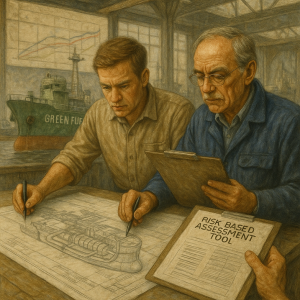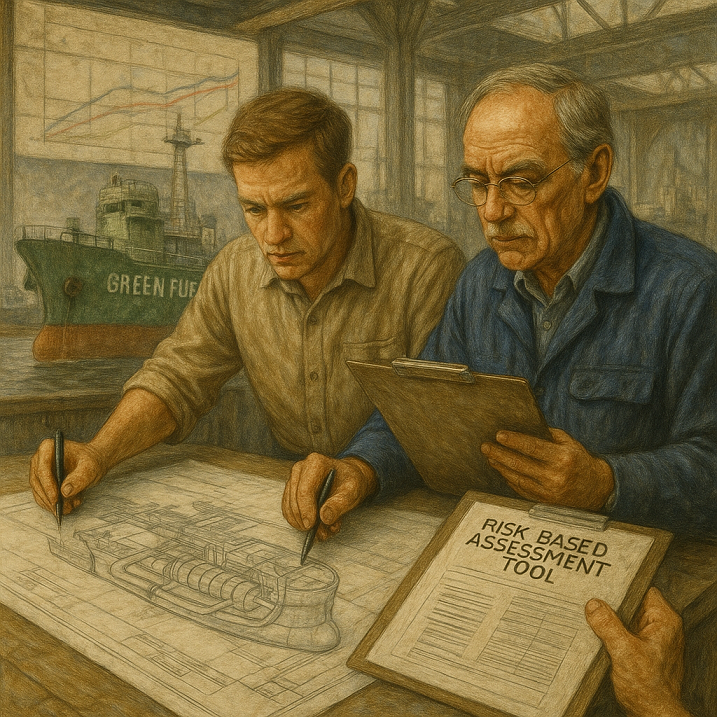Green fuels like hydrogen, methanol, and ammonia are reshaping ship design, but they bring new risks. Discover how marine engineers are using the Risk-Based Assessment Tool (RBAT) to create safer ships, prevent hazards, and meet future IMO regulations.

Why this topic matters in modern maritime operations
Decarbonisation is no longer a distant ambition for shipping — it’s a global imperative. The 2023 IMO GHG Strategy sets a course toward net-zero emissions “by or around 2050,” with intermediate targets for 2030 and 2040. In this transformation, green fuels such as hydrogen, ammonia, methanol, and biofuels have emerged as key contenders. However, these fuels are not simple replacements for marine gas oil (MGO) or heavy fuel oil (HFO). They present complex operational, design, and safety challenges.
To address these risks while fostering innovation, marine engineers are turning to a powerful tool: the Risk-Based Assessment Tool (RBAT). Originally developed for novel ship systems and autonomous operations, RBAT is now being adapted to design safer vessels capable of using alternative fuels while complying with SOLAS, the IGF Code, and flag/class requirements.
This article offers maritime students, early-career engineers, and seasoned professionals a deep dive into how RBAT helps design safer, regulation-ready ships for a green future.
What is RBAT and why does it matter for green fuel ships?
The Risk-Based Assessment Tool (RBAT) is not a single software program but a structured methodology for identifying, evaluating, and mitigating risks associated with non-conventional ship systems. It is most often used when:
- The fuel system deviates from conventional oil-based arrangements.
- New hazards are introduced (e.g., hydrogen flammability, ammonia toxicity).
- There are no prescriptive rules available (requiring equivalency under SOLAS Reg. I/5).
RBAT often follows the IMO’s Formal Safety Assessment (FSA) framework and aligns with ISO 31000 risk management principles. It supports safe innovation by proving that a new fuel system is “at least as safe as” existing systems, which is the bar for regulatory acceptance.
Today, RBAT is especially relevant for marine engineers working on designs involving:
- Hydrogen fuel cells and storage systems.
- Ammonia-powered combustion engines or fuel cells.
- Methanol dual-fuel systems.
- Battery-hybrid propulsion integrated with green fuels.
Key technologies driving RBAT for green fuel design
Hydrogen fuel systems
Hydrogen’s clean exhaust profile makes it attractive, but its risks are unique:
- Extremely low ignition energy.
- Wide flammability range.
- High diffusion rate through materials.
- Cryogenic storage challenges (for LH2).
RBAT must evaluate scenarios like hydrogen leaks in enclosed machinery spaces, venting strategy design, and emergency shutdowns during bunkering.
For example, DNV’s Maritime Hydrogen Safety Guide recommends multi-layered safety barriers and precise gas detection calibration as part of RBAT workflows.
Ammonia combustion and fuel cells
Ammonia is carbon-free at point of use, but brings new toxicity hazards:
- Inhalation risk at low concentrations.
- Corrosive behavior with copper, zinc, and brass.
- Combustion challenges (requiring ignition promoters).
In 2023, Lloyd’s Register and MAN Energy Solutions conducted ammonia engine trials with strict safety protocols guided by RBAT. These assessments included toxic gas plume modelling, double containment systems, and personal protection equipment (PPE) plans.
Methanol-fueled engines
Methanol is liquid at ambient temperature and relatively easier to store. Still, it has:
- Low flashpoint (12°C).
- Invisible flames.
- High toxicity when ingested or absorbed.
RBAT in this context focuses on:
- Ventilation rates in fuel handling spaces.
- Integration of optical flame detectors.
- Dual-fuel engine calibration and automatic switchover safety.
IMO’s IGF Code requires methanol ships to undergo a safety equivalency assessment, typically using RBAT to demonstrate compliance with SOLAS Reg. I/5.
Hybrid systems: batteries + green fuels
Many future-ready vessels will integrate battery-electric propulsion with green fuels, requiring RBAT to evaluate:
- Battery fire and thermal runaway hazards.
- Safe integration with hydrogen or methanol systems.
- Emergency response protocols for multi-energy failure scenarios.
The STENA JUTLANDICA hybrid ferry project used RBAT to simulate lithium-ion battery overheating alongside hydrogen tank loss-of-containment.
Real-world applications of RBAT in green ship design
Ammonia-fueled concept ship: NYK Line, Japan (2022)
NYK Line, in collaboration with ClassNK and IHI Power Systems, developed a concept design for an ammonia-fueled tugboat. RBAT was applied from day one, resulting in:
- Zoned ventilation design for engine room.
- Personal gas monitoring plans for crew.
- Pre-approved emergency handling procedures with local port authorities.
The project helped refine ClassNK’s guidance on alternative fuel RBAT pathways.
Hydrogen ferry: Norled’s MF Hydra, Norway (2023)
MF Hydra, the world’s first hydrogen-powered ferry, underwent a full RBAT-based design approval. Key highlights included:
- CFD simulations of hydrogen dispersion in bunkering areas.
- Modular fuel cell risk assessments using FTA and ETA.
- Integration with Norwegian Maritime Authority (NMA) safety equivalency rules.
MF Hydra became a global showcase for RBAT-driven safety innovation.
Methanol container vessels: Maersk (2024 fleet)
Maersk’s fleet of methanol dual-fuel boxships uses RBAT to:
- Demonstrate engine room safety under worst-case flame scenarios.
- Calibrate optical flame sensors.
- Train crew under IGF Code-aligned protocols.
RBAT documentation supported flag approval and classification society certification (ABS and DNV).
Challenges and how RBAT helps solve them
Lack of historical data for new fuels
One of the biggest hurdles is that green fuels like ammonia or hydrogen lack operational histories in maritime contexts. RBAT allows engineers to:
- Use expert elicitation to estimate risk probabilities.
- Simulate failure consequences using computational modeling.
- Iterate design with real-time learnings post commissioning.
Regulatory fragmentation
Different flag States, port States, and class societies may interpret rules differently. RBAT allows project teams to anchor decisions in evidence, helping:
- Prove equivalency under SOLAS.
- Align with class notations (e.g., DNV’s GAS-FUELLED notation).
- Interface effectively with IGF Code requirements.
Crew unfamiliarity and human factors
RBAT integrates human-centric design by including:
- Alarm usability reviews (avoiding alarm fatigue).
- Training matrix development (e.g., STCW + IGF Code modules).
- Simulated drills based on event tree analysis (ETA).
Integration with digital twins
Some marine design teams are linking RBAT outputs to digital twin platforms, allowing real-time operational monitoring and comparison with predicted risk models. For example, a hydrogen propulsion system’s RBAT data feeds into an engine room digital twin for fault prediction and ESD optimization.
Safety modeling tools embedded in RBAT
Marine engineers using RBAT rely on:
- HAZID/HAZOP: For identifying hazards in early design.
- Fault Tree Analysis (FTA): For tracing system-level failures.
- Event Tree Analysis (ETA): For simulating emergency response chains.
- CFD Tools (e.g., ANSYS, FDS): For modeling fuel dispersion, ventilation, and flame propagation.
- Cost-Benefit Analysis (CBA): To show risk controls are not grossly disproportionate (ALARP principle).
Each tool feeds into the RBAT documentation submitted for regulatory review.
FAQ: RBAT and Green Ship Design
What is RBAT in simple terms?
A step-by-step risk reasoning tool used by ship designers to show a new system is safe enough compared to conventional designs.
Do I need to use RBAT for every green fuel project?
Not always. But if your fuel choice falls outside SOLAS or IGF prescriptive rules, an RBAT-based equivalency assessment is likely required.
Which standards does RBAT align with?
IMO FSA methodology, ISO 31000 risk management principles, SOLAS Regulation I/5, and the IGF Code.
How long does an RBAT process take?
From weeks to months depending on project scale, fuel type, and regulatory complexity.
Can students use RBAT in their design projects?
Absolutely. Many maritime academies now include RBAT exercises in simulator and design training courses.
Is RBAT software-based?
Not necessarily. It can be done with spreadsheets, templates, risk matrices, and modelling software. Class societies often provide guidance.
Conclusion: Building safety into the future of green ships
RBAT is not just a regulatory hoop to jump through — it’s a core design philosophy for the age of alternative fuels. As hydrogen, ammonia, methanol, and hybrid systems gain traction, marine engineers must lead with safety-first thinking.
By applying RBAT early in the design process, shipbuilders and operators can:
- Identify risks before they materialise.
- Justify their choices to flag and class.
- Train crew more effectively.
- Create safer, cleaner vessels that are truly future-proof.
Call to action: Whether you’re a student working on your thesis, a design engineer building your next concept ship, or a chief engineer reviewing new vessel specs — learn to use RBAT. It’s the bridge between innovation and safety in a decarbonising maritime world.
References (hyperlinked)
- International Maritime Organization. (2023). IMO GHG Strategy
- DNV. (2023). Hydrogen in Shipping Safety Guide
- Lloyd’s Register. (2022). Ammonia as a Marine Fuel
- MAN Energy Solutions. (2023). Ammonia Engine Trials
- IMO. (2020). IGF Code – International Code of Safety for Ships using Gases or Other Low-flashpoint Fuels
- Norwegian Maritime Authority. (2023). Hydrogen Ferry MF Hydra
- Wärtsilä. (2021). Methanol Fuel Technology
- ClassNK. (2022). RBAT Application in Alternative Fuel Design

